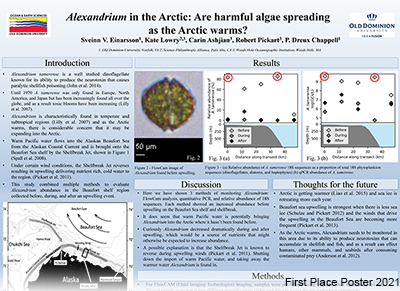ORCID
0000-0002-8335-0094 (Confessor)
College
College of Sciences
Department
Ocean/Earth/Atmos Sciences
Program
Ocean & Earth Sciences (M.S)
Publication Date
4-2021
DOI
10.25883/m0ne-qr05
Abstract
Dinitrogen (N2) fixation is the process of taking widely abundant but mostly biologically inaccessible N2 gas and converting it into more biologically accessible forms of the essential macronutrient nitrogen. Only a small fraction of organisms known as diazotrophs can perform biological N2 fixation. Trichodesmium is one such genus of N2-fixing marine cyanobacteria that is commonly observed in waters along the West Florida Shelf (WFS). We hypothesize that the two main Trichodesmium clades (T. erythraeum and T. thiebautii) occupy distinct environmental niches, one being more coastal and one being more oceanic. To test this hypothesis, we quantified gene abundance of both clades and compared the results with hydrographic data to distinguish any trends in niche distribution in samples collected on the WFS from three separate cruises. T. thiebautii abundance was higher further from the coast (at stations with greater bottom depths) and the T. erythraeum abundance was higher closer to the coast (at stations with lower bottom depths). A lack of nearshore sampling in 2015 initially made it difficult to conclusively identify trends in niche distribution, however with the addition of 2018 and 2019 samples, we observed a consistent coastal vs. open ocean niche separation for the two clades. In addition, T.thiebautii abundance was also significantly positively correlated with salinity. While previous work has found T. thiebautii is more abundant than T. erythraeum in open ocean surface waters, this is the first study to examine Trichodesmium clade abundance in a near-shore environment.
Disciplines
Biogeochemistry | Oceanography
Files
Download Full Text (3.4 MB)
Recommended Citation
Confesor, Kristina; Selden, Corday; Powell, Kimberly; Knapp, Angela; Buck, Kristen; Donahue, Laura; and Chappell, Dreux, "Defining the Environmental Niche of the Two Main Clades of Trichodesmium: A Study on the West Florida Shelf" (2021). College of Sciences Posters. 11.
https://digitalcommons.odu.edu/gradposters2021_sciences/11



